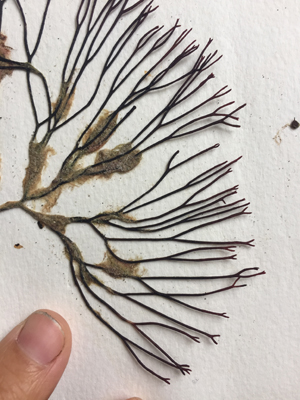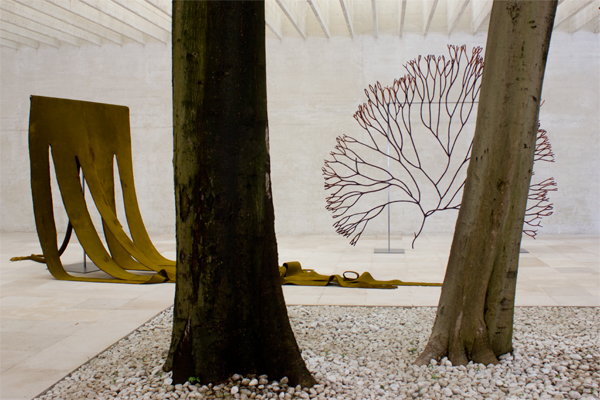A Great Seaweed Day
fieldwork and sculptures
2019
A Great Seaweed Day departs from my stomach – a both tender and sore point where flows of energy and emotions converge. Bowel pain can be caused by a number of things – a feeling of unease, menstrual cramps, too many plums, food poisoning or even a bleeding ulcer. When I lay my hand on my belly, I can feel it rise and fall as I breathe, but still, the tummy lives a life of its own – it remains an ungraspable mystery.
The title is a quote from the diary of the Victorian housewife and marine botanist Margaret Gatty (1809-1873). Gatty's interest in seaweed sparked when aged 39 she travelled to the coast to recover from physical exhaustion caused by the latest of seven strenuous pregnancies. Gatty would give birth three more times but for the rest of her life she combined motherhood with a scientific career in marine botany and a large passion for seaweed. Most of the pages of her diary are full of entries regarding family dinners, visits and other aspects of the life of a high-society woman. On some dates, however, we read: “A GREAT SEAWEED DAY”. Double underlining and capital letters gives an idea of how she felt while squelching around the shorelines.
By way of research and inspiration, but also in a need for rest and recovery during a difficult time in my life, I trotted in Gatty’s footsteps and spent time by the sea – on Isle of Eigg in Scotland, the Koster Islands at the West coast of Sweden and in my hometown Malmö. Walking among what had been swept up by storms and the tide, or while taking a swim, my eyes and fingers were drawn to the many slimy and glittering pieces of algae that I encountered. Sometimes I would pick up the ones I deemed prettiest to take home and dry. I learnt their various names and felt related to their nature as crisp and buoyant while supported by the sea. They emitted a musty smell after some time on land, as their bodies turned limb and brittle.
Ulva Intestinalis, is a thin, almost transparent, tubular green algae filled with small bubbles of air, which enables it to float just below the water surface and drink the light beams of the sun. It is commonly known as mermaid’s necklace or gut weed. For me, it becomes a useful link between the intestinal flora and the flora of the sea – a slippery path that yet again connects my living body with the ocean. If the gut weed is an intestine and the body a marine landscape, the bead of air-pearls inside the algaes cellular membrane become the inner wind of the belly – flatulence.
About one hundred trillion microbes – including bacteria, fungi and viruses – coexist with every human being. Roughly eighty percent of them live in the gut. Microbes proliferate very comfortably in this humid, warm and nutrient-filled environment, feeding on what we have previously fed. Here the term “holobiont” is apposite – an ecological unit in which the host/human body and all the microorganisms that inhabit it come together in a joint entity of mutual dependency and benefit.
The enteric nervous system, ENT or abdominal brain, is a network of nerve fibres surrounding the gut. It communicates with the brain, and generates emotions and physical sensations, often out of reach for the conscious mind. It can create the fluttering of butterflies in the stomach, make us feel unwell, suffer constipation, or experience a true feeling of ease. The concept of having an “upset stomach” connects the psychological and physical – two sides of the same coin.
By using white cotton, polyester and silk fabric, foam plastic, foam rubber, wallpaper adhesive, wheat flour, white glue, hot melt adhesive, nylon thread, acrylic paint, textile dye, polyurethane lacquer, boat lacquer, silicone, crystal clear sealant, aluminium, carbon fibre, wire, polyester thread and cable ties I have made my own collection of seaweed. All of them are a bit too big to be carried – slipping through my arms and fingers.
A Great Seaweed Day is a work that belongs to The Inner Ocean – a multi-part project embracing the fact that I love to swim. The project's title refers to the fluid that encloses mature egg cells in all land-living animals. The liquid has the same salinity as the primal ocean once had – the sea where the first life once arose, several billion years ago.



